How much (or how little) our babies sleep is one of those topics that unites us as parents. We’ve all struggled with it at one point or another. Some babies are great sleepers from the beginning, and others need a lot more assistance and cuddles to fall asleep. Either way, you’ll want to set yourself up for success and safety when it comes to newborn sleep.
For the first four to six months of life, the American Academy of Pediatrics (AAP) recommends that your baby sleep in a bassinet or crib in your bedroom. And since babies are so tiny and their systems are still developing, it’s important to invest in a bassinet that won’t expose your baby to VOCs, formaldehyde, BPA/BPS, flame retardants, and other toxic chemicals — right where they sleep.
Below, I’ve listed the best non-toxic bassinets and co-sleepers currently on the market for your newborn.
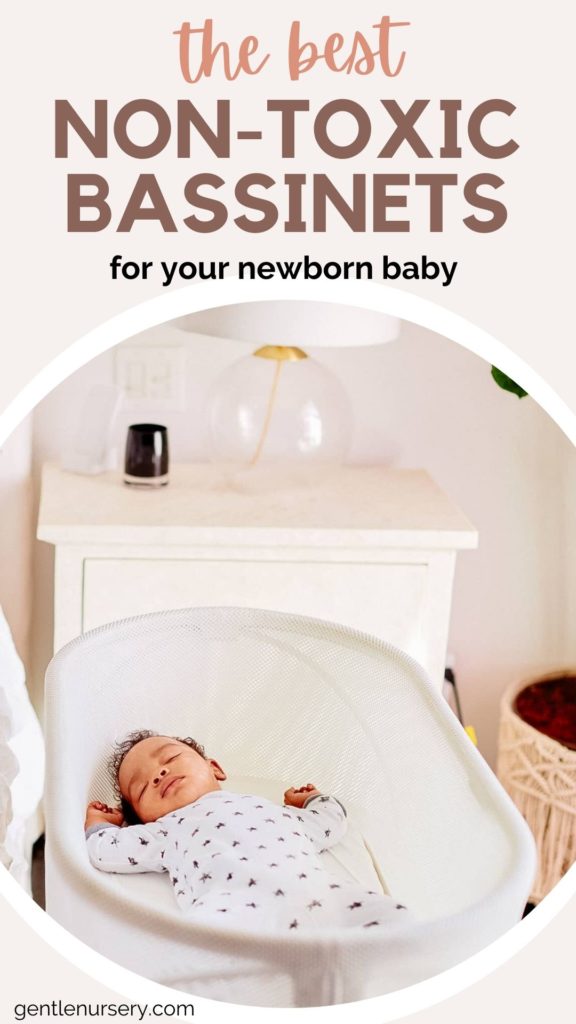
What to Look for in a Bassinet or Co-Sleeper
- Breathable sides. The bassinet that I originally bought didn’t have breathable (mesh) sides, and after a while, it started giving me anxiety because I was worried about my baby turning on his side and putting his face into the side of the bassinet. I think this is one of the most important things to look for in a bassinet.
- Natural, untreated fabrics. Since babies spend so much time sleeping, you don’t want them to be exposed to fabrics treated with chemical flame-retardants.
- Portability. For the first few months, babies can sleep in a smaller, more portable place than a crib. You may find that it’s easier to move a bassinet from room to room for naps, for example. Something lightweight is ideal.
- Stability. I found some newborn baby bassinets to be too lightweight and practically flimsy. You’ll want to make sure that whichever one you purchase will be stable enough to support baby, especially if you have older children or pets at home.
- Height. You’ll want to consider the height of the bassinet or co-sleeper when making a decision. Both my babies have woken up a lot at night, and I found myself getting exhausted at having to keep getting out of bed every time to get them. With my first baby, I wish that I had gotten a bassinet that would have allowed me to have the baby in his own sleeping environment, but just at an arm’s distance. (And with my second, I did – I got this bassinet. It’s not perfectly non-toxic but I was comfortable with the choice.)
The Best Non-Toxic Bassinets & Co-Sleepers
When it comes to non-toxic bassinets, I feel that there is sadly no perfect option out there that meets all of the important requirements. It’s frustrating because it could be so simple for one company to swoop in and make a truly all-around non-toxic bassinet. But there still are a handful of great options for you to choose from!
Here’s my list of the best non-toxic bassinets and sleep options for your baby’s first few months.
1. BABYBJORN Cradle
The BABYBJORN Cradle delivers big with breathable sides, Oeko-Tex certified fabric, and lightweight portability. It also rocks back and forth, which helps soothe babies back to sleep in those early months. The fabric and mattress cover are removable for easy washing, too. The cradle is manufactured in Bosnia and Herzegovina, but please note that even though they use non-toxic fabric, the cradle does contain an MDF board below the mattress. I’m disappointed that such a conscious company would use MDF in their baby cradle, but they assured me that it does not contain formaldehyde.
Buy on
2. Halo Swivel Sleeper Bassinet
The Halo Bassinest has become a very popular option among parents. It’s hailed as a great alternative to bed-sharing because it allows you to just almost barely bed-share by being right next to your bed, but still gives your baby her own sleeping space. This is the bassinet that I chose for my second baby because I have an impossibly high bed, and I am really happy with my decision.
Here’s the lowdown on the Halo: (1) it offers breathable mesh sides so you don’t have to worry when baby starts scooching to be closer to you or rolling to his side, (2) it is BPA-free, (3) it has a height-adjustment feature and a base that can be tucked under your bed to allow you to get baby super close to you in bed (making it much like bed-sharing), but also allowing you to save space, (4) it has a drop-down side wall that allows you to easily get baby out of the bassinet without completely getting out of bed (yes, this does matter!), (5) it rotates (or swivels, I guess) to allow you to get out of bed easily, (6) and it has a built-in nightlight and vibration feature (only available in the luxe series).
The downside is that the HALO contains polyester and polyurethane foam, though the manufacturer claims no flame retardants are used in any of their products. Thankfully, HALO does offer an organic bassinet mattress that is also free of chemical flame retardants and VOCs, which I recommend.
Buy on:
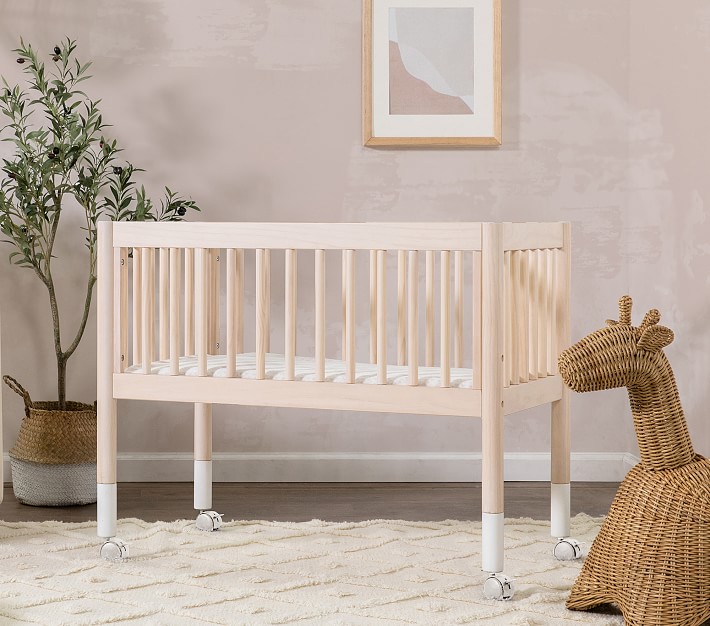
3. Babyletto Gelato Portable Bassinet
This beautiful mini crib by Babyletto is a wonderful option for your non-toxic bassinet. Greenguard certified and made with sustainably sourced New Zealand pine, this beautiful bassinet uses non-toxic finishes that are lead and phthalate-free.
The Gelato comes with a 1″ waterproof pad but Babyletto recommends replacing it with their Pure bassinet pad. This gorgeous bassinet allows you to keep your baby close by while not taking up a tremendous amount of space in your bedroom.
Buy on:
4. Venice Child Bedside Bassinet
Venice Child is a California based brand (in Venice, CA), and they have a really nice modern-looking bassinet that also doubles as a bedside sleeper. It sits at bed level and has multiple height adjustments, which is exactly what you need in those early postpartum months when recovering from birth (especially those who have had a c-section) and the baby wakes up for multiple feedings. This bassinet also has a mesh side so you can easily monitor your baby. The mesh side also ensures that your baby receives optimal air circulation even if your little one scoots around in his sleep.
This portable and breathable bassinet has polyester fabric for the outer bassinet material as well as for the mesh side. The mattress is soft compressed cotton and has a bamboo fabric liner which is washable (always key!). It also has a storage shelf for any extra diapers, wipes, or sleeping clothing you may want to store. As the name indicates, this crib is portable and can be folded flat for easy, compact storage. Note, this one is made in China, which is not ideal, but I can attest that they have very clean testing for chemicals and toxins (including heavy metals).
Buy on:
5. babybay Bedside Sleeper
An amazing, non-toxic co-sleeper that attaches to your bed, the babybay is made with sustainably sourced eco-friendly beechwood and water-based no-VOC or low-VOC paints. It uses no plastic whatsoever, and contains no glues either. Consider this a more natural version of the Arm’s Reach Co-sleeper that is made from wood.
The babybay is manufactured in Germany and is designed to support breastfeeding and safe sleep up to approximately 6 months of age. Though it’s on the pricey side, it’s a great investment in a safe sleeping space for your baby. Keeping your baby so close to your bedside can be better for both mom and baby, encouraging better bonding during sleep and making it easier to take care of your baby during nighttime wake-ups. The babybay assembles in approximately 15 minutes and can be converted into a crib or changing table later on.
The mattress is made from polyurethane foam, as are most bassinet mattresses. Some of my readers have had luck ordering the European version of the mattress.
Buy on

6. Guava Lotus Travel Crib
One of my favorite non-toxic play yards, the Guava Lotus now offers a bassinet conversion set. The Lotus is about as non-toxic as it gets: the travel crib is free of free of PVC, Lead, Phthalates, Formaldehyde, Heavy Metals, and chemical flame retardants. It is Greenguard Gold certified and has breathable mesh sides. It’s wonderful, and now the company also offers a bassinet conversion kit! So much like a Pack n Play with a bassinet option, the Guava Lotus now comes with a bassinet — only better and non-toxic.
Buy on:
7. Nuna Sena Aire
Another play yard to make this list, the Nuna Sena Aire features a bassinet that makes me fall more in love with it. It is an attachment that hooks on to the full-sized play yard, meaning that it is more spacious than the Lotus bassinet. Newly redesigned, the Sena Are provides 360 degrees of air-flow while your baby sleeps or plays.
I have the Sena Aire, and while I didn’t use it as a bassinet, I can confidently say it was one of the best baby product investments I made. I love how sturdy it is compared to the Guava Lotus crib, and my littlest one loves to play in there.
Many home-cooked dinners have been possible in my home because of the Sena Aire.
Buy on:
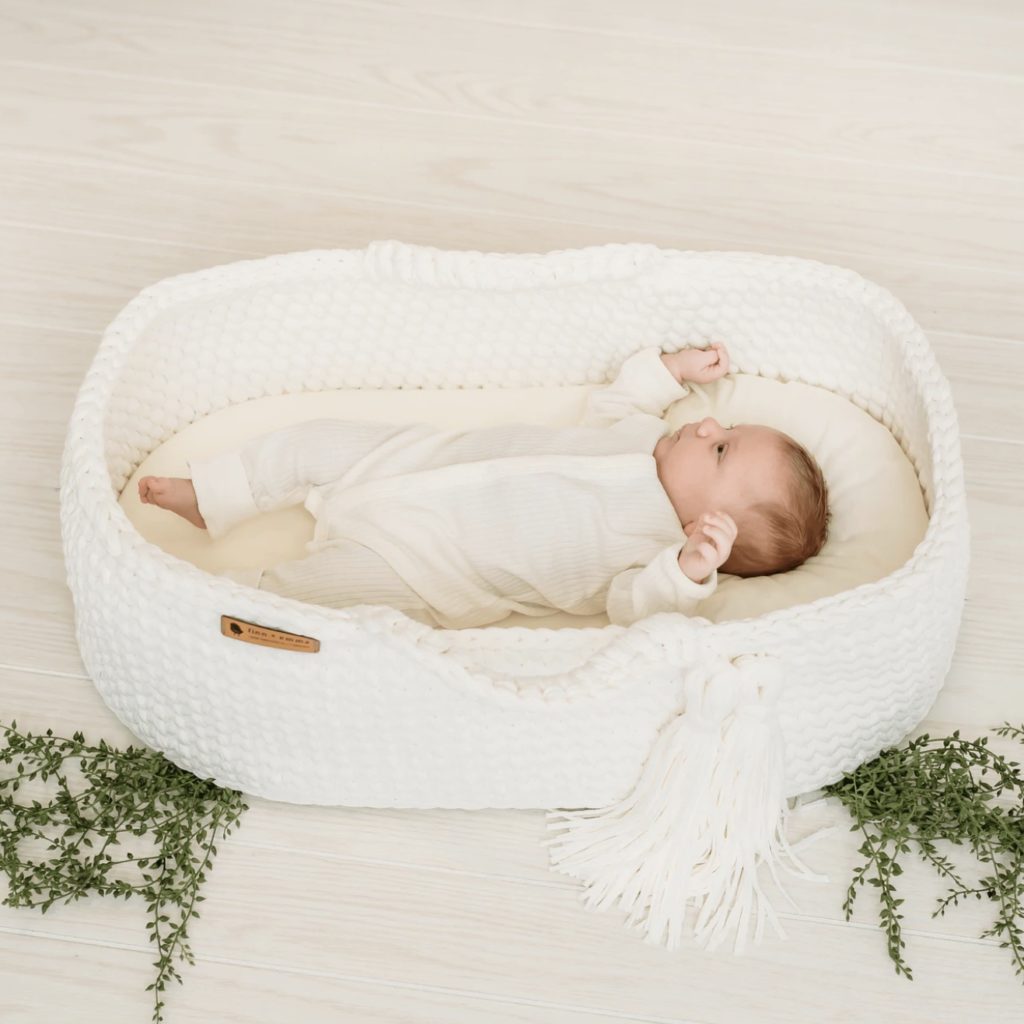
8. Finn and Emma Carry Cot
More of a Moses basket, the Finn and Emma carry cot is made of safe materials that give you peace of mind. The basket itself is made from crocheted soft organic cotton and comes with a mattress and removable pillow (which is not recommended for safe sleep reasons). If you are open to using a Moses basket, the Finn and Emma can be a great non-toxic bassinet or can even be used for supervised naps around the house.
9. Oeuf Fawn Crib and Bassinet System
A convertible system, the Oeuf Fawn starts as a bassinet and can later be converted into a full-sized crib. It is made in Europe with non-toxic, water-based low-VOC paints, Birch plywood and eco-MDF (not ideal materials, but it does meet GREENGUARD Gold certification standards for low emissions). Oeuf makes an effort to limit formaldehyde in its products, though they are quick to point out that formaldehyde is naturally occurring in wood in small quantities. The company also only uses water-based glues when manufacturing their MDF. Though I don’t have any firsthand experience with the Fawn Bassinet, and there aren’t many reviews to go off of, I think this is still a great option to consider, especially for families living in smaller spaces.
Buy on
10. Arms Reach Co-Sleeper
Newborn sleep isn’t a perfect science, so I’ve listed a conventional product for you to also consider. I don’t enthusiastically recommend this since safe sleep to me also means cutting out as many toxic chemicals and materials as possible. But I do recognize that sometimes conventional products make more sense.
The Arms Reach Co-Sleeper has been a popular choice among parents who wish to co-sleep without bed-sharing because it actually attaches to your bed. It’s definitely not the prettiest option available, but it is a functional choice for having baby near mom at night. A lot of my mom friends have used the Arm’s Reach and been happy with it.
It does have breathable sides, and a nice storage compartment below where the baby sleeps, for added convenience (i.e. you can change diapers in here!).
Newborn Safe Sleep Recommendations
The AAP has issued safe sleep guidelines, including but not limited to: always put children to sleep on their back, use a firm sleep surface, avoid bumpers and soft objects in cribs, room-share (but not bed-share), breastfeed, and use a pacifier at naps and bedtime. Read the safe-sleep guidelines for more information.
Even though the theory that SIDS is connected to toxic chemicals in baby mattresses has essentially been disproven, I personally can’t write off the idea. Plus, knowing everything I know about flame retardants and polyurethane foam off-gassing, I think it’s just simply prudent to choose a safer, non-toxic bassinet.
So, given all of the risks and uncertainty – and the general importance of reducing your baby’s exposure to toxic chemicals – I feel it’s important to invest in non-toxic bassinets, organic crib mattresses, and organic bedding for your baby’s sleep.
Do Babies Need a Bassinet?
The AAP recommends that babies sleep in the same room as the parents (but not in the same bed) for the first six months of life, preferably until the baby’s first birthday. Most families can’t fit a crib in the master bedroom, so another sleeping solution is usually needed. For the first few months, I do recommend that you have your baby sleeping in a bassinet or co-sleeper in your room, although it’s good to try to have your baby nap in their crib once a day so that they can get a little used to it from the beginning. It makes transitioning them to the crib a lot easier later on.
Important: If using a bassinet, Moses basket, or co-sleeper, you must discontinue use once your baby starts showing signs of rolling over, pulling up, or kneeling. Follow the manufacturer’s instructions carefully.
Which of these non-toxic bassinets and co-sleepers do you think will work best for you? Be sure to read our guide to safe-sleep for babies.

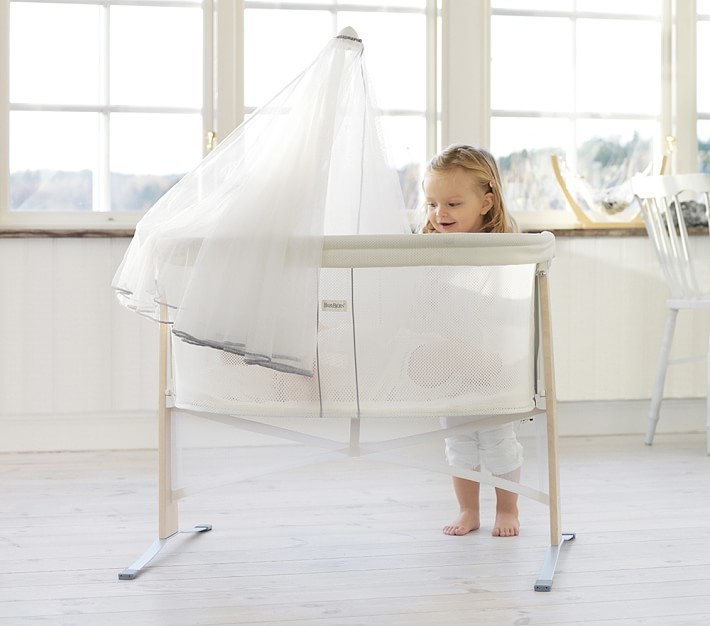

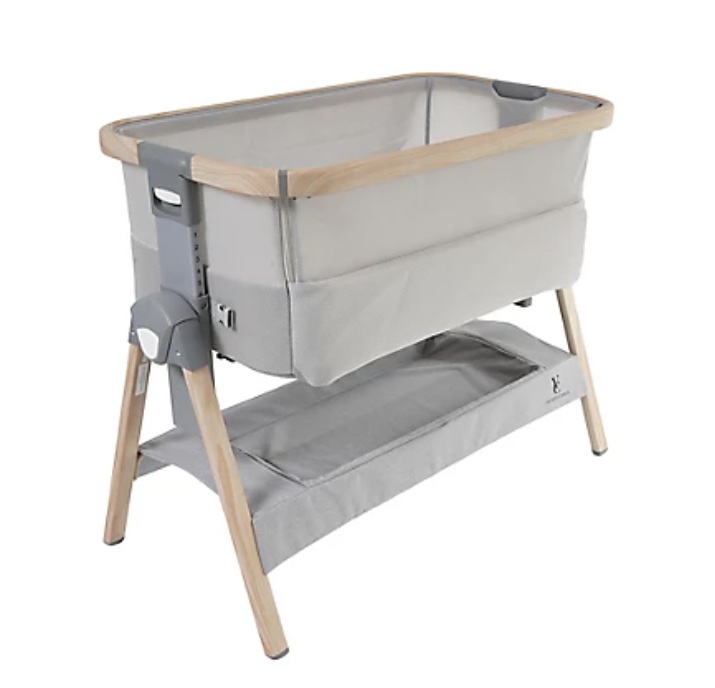

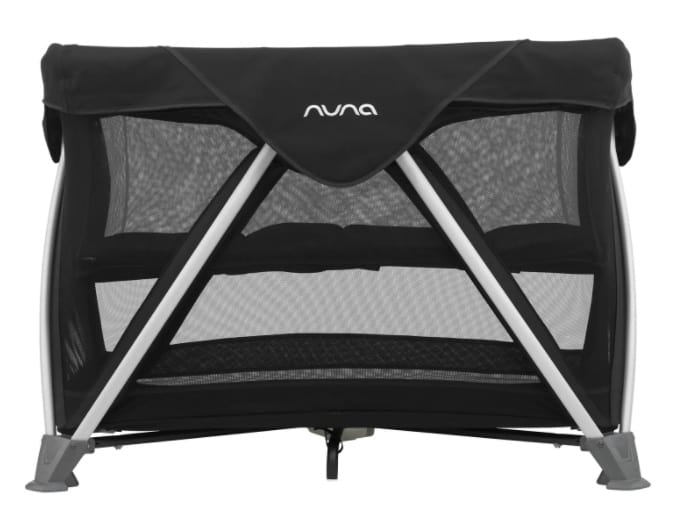


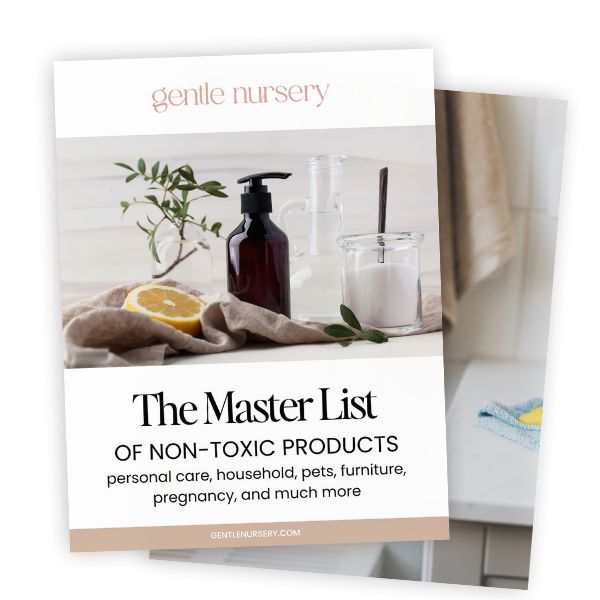
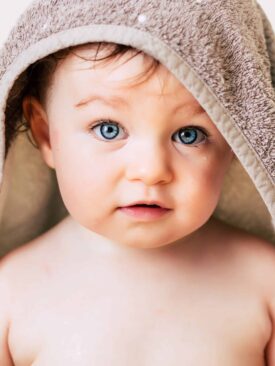
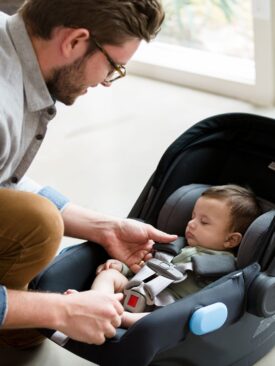
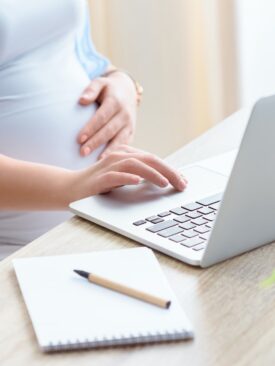

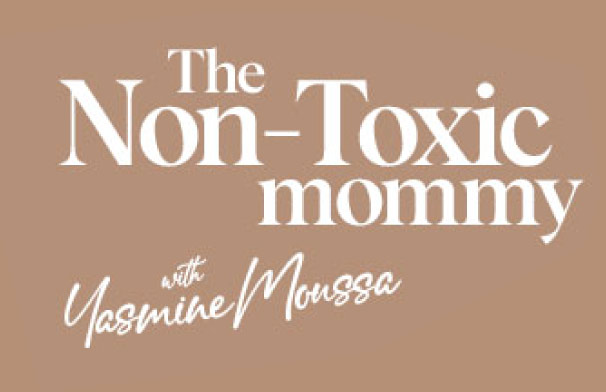
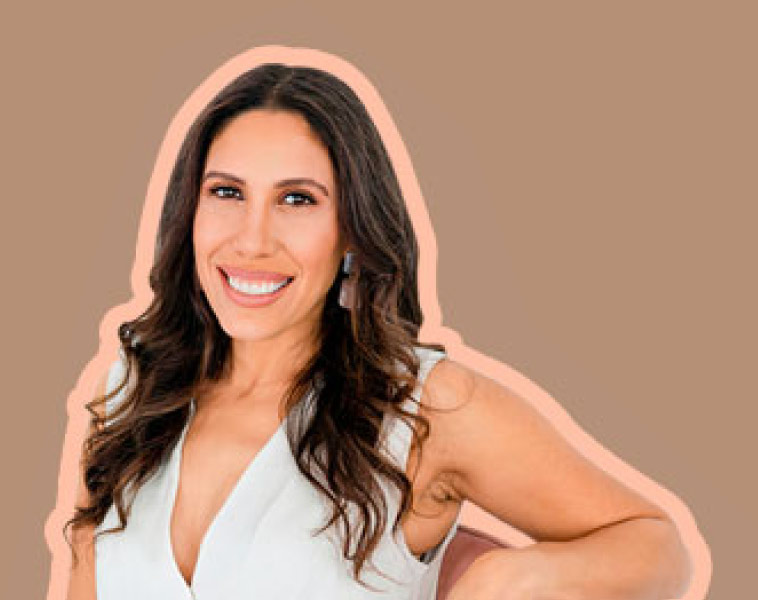

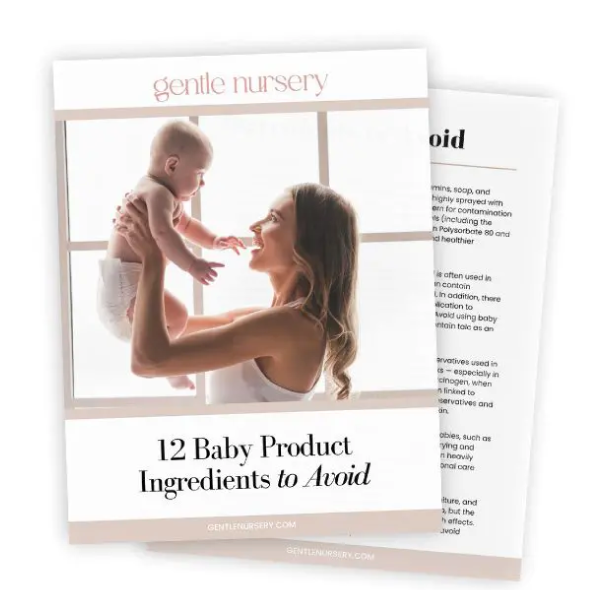
Hi Yasmine! Thanks for this post. Do you have any discount with Guava? I’m getting the bassinet attachment for #2 due in a couple months. Also, just sharing some info regarding the alternative mattress for the babybay that I’ve seen suggested by some members in the group. The manufacturer told me that they use latex glue that is not certified and has additives.
Hi A****,
Thank you for your patience.
The supplier has advised our product team that the latex used is not GOLS certified because it has non flammable additives.
I hope this helps!
Hi mama! Thanks for your question. I do not have a Guava discount code. I wish I did!
Thank you for the note about the Babybay. I wonder what they are referring to…
I was considering the Nuna Sena but am not seeing anything about the mattress being on toxic on their website. It appears to have a plastic insert and mesh cover, but I haven’t been able to find any information on the material used.
Hi! I know you recommend the UppaBaby stroller which comes with a bassinet. I saw you can buy a bassinet stand to use it with inside. What are your thoughts on using the UppaBaby bassinet for sleeping?
Is the Baby Bjorn cradle mattress hard enough for sleep? I have a friends and it seems very soft and from everything I’ve been reading the mattress should be very firm. Also, I looked into buying a replacement mattress on Babybjorn’s website and it says it is made of polyether foam… isn’t any foam toxic? The cover has polyurethane in it, isn’t that toxic as well? Just curious your thoughts on this. I want to make the safest, non-toxic decision for my baby. Thank you!
Hi, thank you for this helpful post! Would you recommend a waterproof mattress protector or something in addition to the included sheet for the Nuna Sena Aire? Thanks!
Thank you for this post ! I’m considering the Halo bassinet + organic replacement mattress but I’m curious what you used as a waterproof cover for this oddly shaped mattress. The replacement mattress stats say it’s only “water resistant” which makes this first time mom nervous !
Hi! No waterproof cover was needed, even through diaper leaks. It held up fine 🙂
Thank you for this post- it’s very helpful! Looking at the Halo organic mattress replacement, it looks like only the cover is organic cotton and the rest of the mattress is the same toxicity as the original. Do you know if that is the case?
Hi! Yes I believe that’s correct. I was disappointed once I realized that. I love the halo for its features and convenience but it isn’t as clean as some of the other bassinets listed here.
That’s too bad. We have the bassinest but aren’t sure how to get a non-toxic mattress. Even the pad that comes with it is 100% polyester.
Naturepedic makes custom bassinet mattresses. I think I can put you in touch with someone. Believe they aren’t too expensive.
Just wanted to clarify that the organic HALO mattress is a no-VOC mattress and is made without flame retardants. Sorry for the mixup!
Just wondering if you had any luck getting a natural/non-toxic mattres for this bassinet. I called natirepedic and they said they don’t make one for the halo (not even custom) because it could pose a safety hazard in combo with the soft sides of the halo. I’d love to find a way to use this bassinet and am not clear on whether halo uses flame retardants because they say they don’t use any “non-toxic flame retardants” but I can’t figure out if they use some that they don’t consider non toxic, or if they don’t use any at all.
I’ve emailed Halo and I will check to see if the mattress has a TB117 tag on it. Please stand by and if you don’t hear back from me in a couple of days don’t hesitate to check in 🙂 When is your due date?
Hi Monique, the mattress does not have a TB 117 tag. I will update once I hear from Halo, but it does not appear the mattress is treated with FRs.
They (Halo) do not use any flame retardants on their products.
What do you think about the 3-1 arms reach? They offer it in the mini and ideal ezee. Would love to know your thoughts!
https://www.buybuybaby.com/store/s/arm-reach-3-in-1/?pstate=&ta=typeahead&ml=v2
Hi! Arms Reach is a very popular sleeping option. Lots of mom’s love how close you can keep your baby and it gets lots of positive reviews. I personally didn’t go with it because it is made with PVC. And I liked the Halo Bassinest better. The Arms Reach didn’t feel as sturdy as I was hoping, but I think it comes down to how much of a priority it is to “cosleep” with your baby by your bedside. So ultimately I think it’s a good option (though not non-toxic in the least) but I prefer some of the other options I’ve listed here.
Do you know much about the Dock-a-Tot co-sleeper and the Carter’s by DaVinci Colby 4-in-1 Convertible Crib in terms of non-toxic-ness?
https://www.amazon.com/Carters-DaVinci-Convertible-Trundle-Drawer/dp/B07281JCMV?th=1?
Thanks in advance!
DaVinci is greenguard certified but they manufacture in Asia. That’s my only gripe with their furniture. A good option especially if you’re on a tight budget. Dock-a-Tot is great! I use the Snuggle Me Organic but I thought I read that Dock-a-Tot uses GOTS certified cotton but now I can’t find that info. Stand by!
Thank you!. I came across this: https://dockatot.com/blogs/news/why-the-dockatot-is-not-organic
What are your thoughts on this?
Hi Jessica! This is the blog post I was looking for. Thank you! This is a great certification to have and I would feel very comfortable with the Dock-a-Tot because of this. They go so far as to state that 100% of their materials meet this certification standard. Snuggle Me Organic also has a breakdown of their standards and certifications here: https://www.snugglemeorganic.com/organic-certification